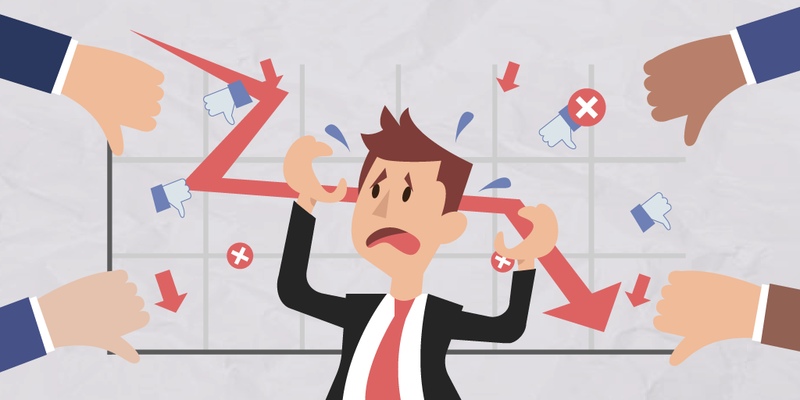Measuring a customer service strategy plan’s effectiveness is not always easy. A strategy must consider all static and moving parts of a business. All these aspects have to harmonize to provide exceptional customer service.
But sometimes things go wrong — and we mean horribly wrong.
In this article, we’ll be taking a look at a few examples that show how your customer service strategy may not be working.
If you're more interested in "what" than "why", we’ll be glad to help you come up with your new customer service strategy!
1. Not Listening to Your Customers

A business is not a one-way street, in which managers feel like they owe customers nothing. The first of many customer service rules is that business is akin to a dialogue between two parties.
In other words, customers need to know they are being heard.
Hard to Reach
Effective customer service strategies provide channels through which customers communicate with a business. We’re talking about a website, social media channels, surveys, and yes, even a telephone.
What’s more, communication shouldn’t be difficult.
If customers have to browse page after page on your website in a desperate bid to find the contact information, then guess what, your customer strategy is failing.
One of the first rules of customer service guidelines is to prominently display your business's contact information. Make yourself available for a conversation with customers.
Despite the accessibility of the internet, 80% of business communications are done by phone. 85% of people whose call keeps ringing will never call back, and 94% of customers say that they move on to another company if the phone isn’t answered.
These striking statistics are a warning to your business — be available!
If you can’t be available to pick up the phone — and not every business has service representatives available 24 hours a day, seven days a week — then ensure alternatives are working effectively.
Or, set up a voicemail system. Your customer service strategy plan should never ignore any single voice. Every customer counts.
If you have a website — and there’s no reason why you shouldn’t — don’t forget to pay your web hosting. More importantly, set up a clear feedback form for people to post their comments and questions.
Online chat help is another great avenue to extend your customer service to the web. Don’t use it as an alternative to a feedback form — rather, use them in conjunction with each other.
91% of consumers prefer to use an online knowledge base, if it is available and easy to use. Look, here’s a niche to fill. Fail to do so, and another company will swoop in and do it for you.
Turning Criticism Into Change
So, you have channels through which customers can express their opinions: social media, surveys, or online review sites such as Google Reviews. You’re on the money when it comes to exceptional customer service.
But it’s not enough to provide an avenue for customer’s concerns. Businesses have to listen and act on customer feedback.
Imagine thousands of people complaining that Walmart needs to, say, hire an extra cashier so the lines aren’t overflowing with customers during the rush hour. And since so many people complain, the local paper picks up the story.
If the only thing that changes is a Walmart representative saying “We value customer feedback”, then that particular Walmart begins to look disingenuous. A loud complaining risks ending up as an all-out riot, complete with protest signs and soapboxes.
Not only will customers stop leaving comments and responding to survey, they may leave your store for a competitor while telling 9 to 10 other people about their bad experiences.
Not listening is the epitome of shooting yourself in the foot.
It means not only do businesses show little respect for their customers, but they also miss out on an opportunity for self-improvement. And self-improvement is the core of any effective customer service strategy plan.
2. Failing to Use Data

What’s the point in stuffing digital warehouses with data if you’re not going to use it? That’s a rhetorical question.
Because if your business is not using the data it collects, you are failing your customers.
Sitting on valuable data is a waste of space, resources, and your customer service team’s efforts. That doesn’t mean you ought to forego data collection altogether.
Don’t let footfall analytics data on your best customers collect cobwebs on the cloud — put it to good use. Keep in mind, of course, that if you try to use every sliver of data concurrently to make strategic decisions, you will be overwhelmed.
It’s just not possible to use all the data all the time. The trick to using data in an effective customer service strategy plan is to segment data collection into categories.
For example, identify your best customers: the ones who regularly shop in your store — say, on a weekly basis — and then use data gathered about them to make strategic decisions targeting one area of the business.
Establish a Mission
It helps to have a goal in mind when collecting data, something to improve your customer strategy. Ask yourself ahead of time, “What do I want to get out of data analysis?”
After all, goals are how we navigate through life. Maybe you want to improve queuing times or incentivize impulse purchases, or discover how many customers renege in your store on a weekday.
Having a goal will automatically narrow the data set. Fit each piece of data into a targeted mission to improve your overall customer strategy and implement exceptional customer service.
3. Undervaluing Your Staff

An often overlooked but perhaps the most important element of your customer service strategy is your staff. A business’ frontline employees have to be empowered to succeed in the digital age.
Want to know what doesn’t work? Minimal training. Hiring your employees and throwing them to the wolves on the floor — and then blaming them for any issues they have.
Give your employees the resources and background training they need to succeed as part of a customer service team. A customer service manual highlighting the most common facets of the job might help.
Empower Your Employees
Another avenue that doesn’t work is forcing employees to follow bureaucratic procedures. By that, we mean taking away an employee's ability to act in complex situations, and telling them to seek a manager first.
Not only does stripping employees of their autonomy hinder their ability to work, it also prevents effective customer service strategies.
Customers don't want to ask an employee a question and be told that the employee has to seek guidance from their superior. What should be a simple response turns into another queue — yet another hassle for customers.
They just want to get what they need and get out, as simple as that.
So the lesson here is, hire the right people. Give them the tools they need to succeed, and leave them alone to do their job — that’s the core of American business consultant Jim Collin’s philosophy.
Not Acknowledging Employees
When employees do well, managers need to thank them. It’s such a simple gesture. Yet, simple gestures carry massive weight.
When managers act as if good work is simply, “part of the job,” they give employees no incentive to keep up what they're doing. They give them no reason to continue following the best customer service rules as part of a customer service team.
Don’t just reward your all-star workers—hanging a placard up and then telling other workers they ought “to be more like X.” That’s an easy way to strain any harmony in your company.
Thank everyone who does well. Even the new worker. When they hone in on a task and begin to excel, praise them; don’t ignore them.
Recognition goes a long way in fostering a positive employee atmosphere, translating into exceptional customer service.
4. Lines That Are Way Too Long

If you customers are waiting for unapologetically long times in line, your customer service strategy is flat-out not working.
I’m talking to you: the business with multiple desks, with customers staring at their phones trying to avoid the anxiety of not knowing when they’ll be attended to.
Customer service is a bulk process. It encompasses everything the customer experiences with your business. It also includes what happens before the customer walks in and after they leave — and especially what happens just before check out.
Even if the entire in-store customer journey is smooth, if that queuing process isn’t, the customer is going to leave with bitter feelings. People remember the beginning and end of a sequence, so make the most out of it.
Adopt a customer service strategy that minimizes the pain of waiting in line.
We’ve mentioned just a few areas that can be improved to provide effective customer service strategies. Of course, building a better customer strategy isn’t easy, but nothing in life that’s worth pursuing comes easy.
Recognizing the aforementioned faults goes a long way in improving customer service.
But if there’s anything to take away from this article, it’s that recognition isn’t enough. If businesses want to thrive, they have to see where their customer service strategy isn’t working and act in a way to improve those aspects.
Doing so is the main key to exceptional customer service.
Got everything covered but need help with managing the waiting experience? Qminder is free to use for 14 days. Give us a try and turn the bitter waiting time into a great customer experience.






